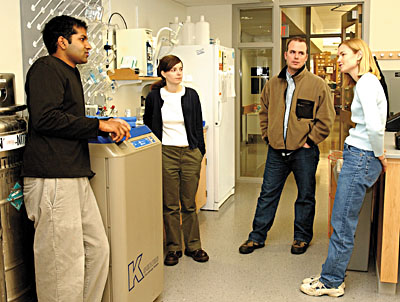
 SPECIAL
SPECIAL ISSUE
ISSUE 2002-2003
2002-2003 |
| VOLUME 3, NUMBER 1
VOLUME 3, NUMBER 1
 | The 300 Cedar St. building will bring together students, faculty and researchers from both the School of Medicine and Science Hill. |
The finished building lives up to that goal in more ways than one. The north wing of the building consists of three floors of technologically advanced teaching facilities that fit with the building's collaborative learning environment.
The space has been designed to improve interaction among students and faculty. Instead of traditional straight workbenches, U-shaped workstations promote collaboration. Students can also sit and discuss their work with each other and with faculty on inviting built-in wooden benches beneath the many large windows that flood the halls with natural light.
The building will also serve as a base for scientists and students from Science Hill. Students get the benefit of not only interacting with peers from many different departments, but also of having one-on-one interactions with world-renowned researchers in their fields.
Since 1839, Yale medical students have been required to complete an original research thesis. This is a critical part of the curriculum that helps develop students' judgment, self-education and their ability to apply science-based medicine to clinical problems.
Yale medical students are able to discuss the basic science behind many common diseases. The new space allows professors to advance the School of Medicine's curriculum by integrating course materials across different departments. They will be able to implement more case-based teaching; link the basic and clinical sciences more seamlessly; and allow students more structured time to conduct original research toward their thesis requirement.
The building's education wing features an advanced anatomy laboratory, a histology laboratory, seminar rooms and a 152-seat auditorium.
For years, students in first-year gross anatomy and histology courses have attended classes in overcrowded laboratories that were originally intended for 50 students and lacking modern air removal and computer systems.
The medical school's need for a new anatomy laboratory was met with a facility that has up-to-date air-handling equipment, computer connectivity and adequate space for the intensive anatomy education Yale wants to provide. Computers are mounted above each dissection table, and teaching spaces have large screens and projectors.
The human anatomy course is a unique program that utilizes dissection, radiology and computer activities to solve spatial relationship problems and to determine the anatomical basis of clinical diagnosis and pathogenesis. The course is fully integrated with an introductory course in radiology. This feature is not found at most other medical schools.
The new histology teaching laboratory is located close to the gross anatomy laboratory and to the Jane Ellen Hope Building and the Brady Memorial Laboratory, where lectures for medical students will continue to be held. There are computer network connections at every laboratory and seminar-room workspace, as well as wall monitors and other audiovisual display systems.
According to Yale anatomy professor William Stewart, Internet access will allow students to "feel the bile duct, look at an X-ray and look up information about it on the Web all at once."
The six new seminar rooms are conducive to the school's emphasis on small-group teaching, a major part of the four-year curriculum. They are dispersed among the laboratory spaces throughout the building.
According to Dr. Herbert S. Chase, professor of medicine and deputy dean for education, in recent years the faculty has moved to structure the curriculum increasingly around small-group learning and the use of technology.
"We've cut out 25% of the time in the classroom in the past two years," said Chase. "The new facilities should help speed the transition to this type of learning."
The new 152-seat auditorium links the building's teaching and research wings and will bring students and faculty together for lectures and conferences.
Facility Marks Major Step in Yale's $500 Million
Space Will Help Transform the Face of Medicine
Scientists Join Forces To Delve Mysteries of Human Disease
High-Tech Classrooms Promote State-of-the-Art Learning
Donors Helped Medical School Vision Become a Reality
Center Will Expand Breakthrough Research Using Magnetic Resonance
Building for the Future Continues
High-Tech Classrooms Promote State-of-the-Art Learning
Educating the School of Medicine's medical and physician associate students in state-of-the-art teaching facilities that are in tandem with quickly evolving scientific methods was a major goal when planning 300 Cedar St.
Developing Students' Self-Education
Anatomy and Histology Laboratories
Investment in the School of Medicine